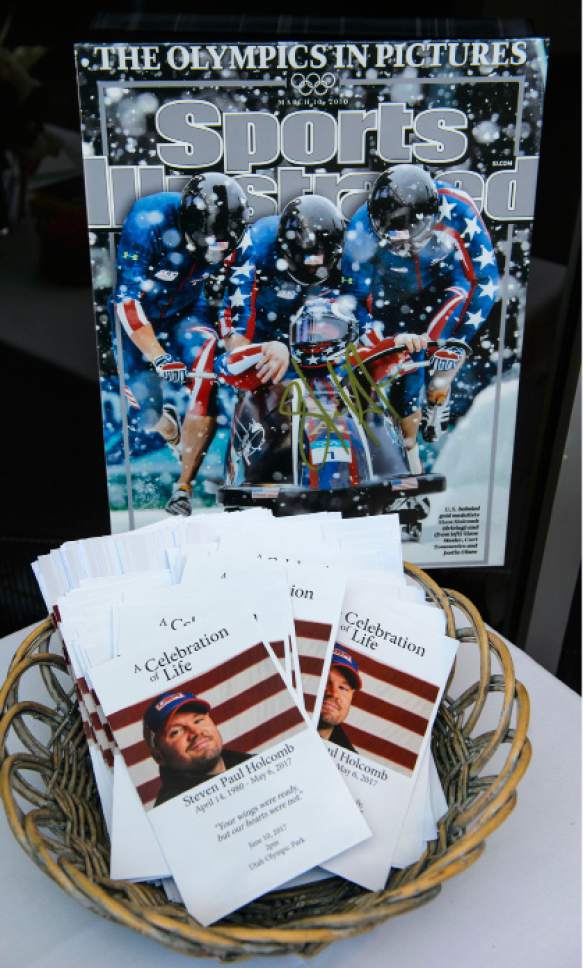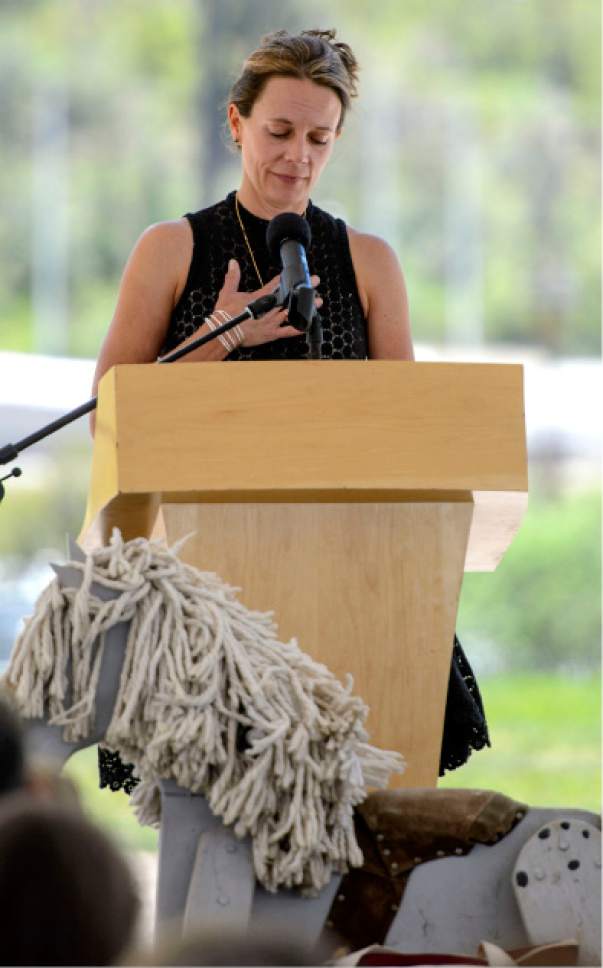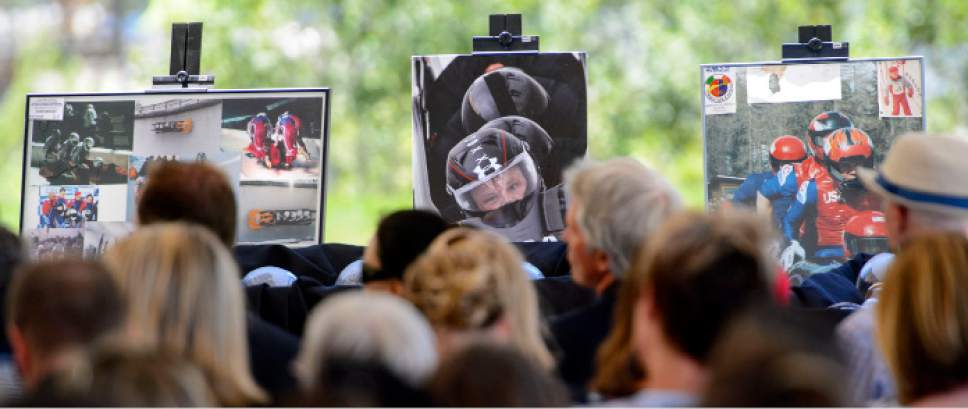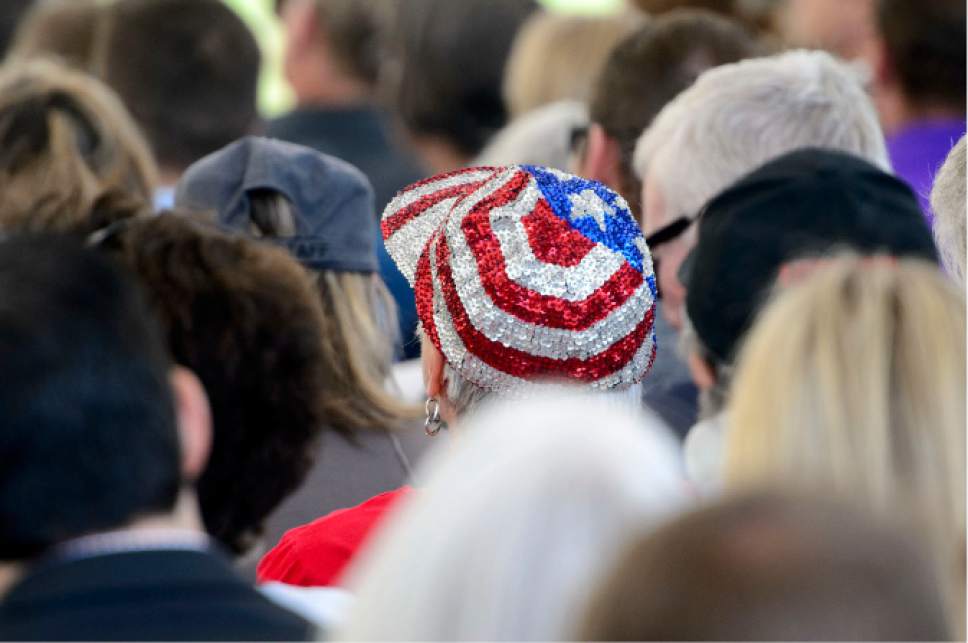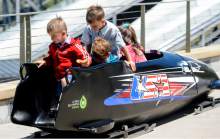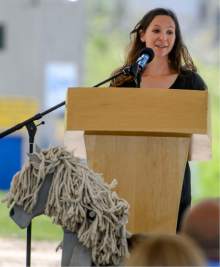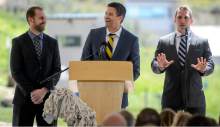This is an archived article that was published on sltrib.com in 2017, and information in the article may be outdated. It is provided only for personal research purposes and may not be reprinted.
Park City • The rumblings echoed throughout the track cut into the tight, jagged canyon along the Wasatch Back. A sled was approaching one of the final turns at the Utah Olympic Park.
And from the summertime patio of the Quinney Welcome Center, the hundreds seated and dozens more standing listening to speaker after speaker, anecdote after anecdote, heard that familiar grumbling of a bobsled approaching.
This continued throughout the two-hour ceremony, dubbed a celebration of life honoring one of Utah's most-decorated Olympians and one of Park City's most-famed sons.
Fitting for the moment. As speakers stepped to the podium to pay tribute to Steven Holcomb, some had an accompanying Holcomb-style soundtrack: The noise of a sled zooming down the same track that helped launch Holcomb into Olympic superstardom.
"One of a kind," said Darrin Steele, CEO of USA Bobsled & Skeleton.
"A local boy made good," said Dr. Brian Schiller, Saturday's officiant.
If there were any dry eyes underneath the canopy where people listened to stories of the 37-year-old bobsled driver who won three Olympic medals, including the historic gold at the 2010 Games in Vancouver, they were certainly hard to spot. Tears from recalling happy memories flowed. Tears for a brother, son, teammate and friend lost flowed a bit stronger.
"We say goodbye to him," said friend and American skeleton athlete Katie Uhlaender, "but in a way he isn't gone. We're just behind him like most of his competitors were on the ice."
Holcomb passed away unexpectedly in his sleep on May 6 in his room at the U.S. Olympic Training Center in Lake Placid, N.Y., sending shockwaves throughout not only the Utah Olympic community, but the entire Olympic order.
A number of former Olympians were in attendance, including Uhlaender, 2002 gold medalist skeleton athlete Jimmy Shea, freestyle skier Shannon Bahrke and U.S. bobsled teammates Steve Mesler, Curt Tomasevicz and Chris Fogt.
"As we try to say goodbye to Steven it's really hard," Steele said, "because he's everywhere that we look in this sport. He's all around us."
Two black bobsleds sat on the patio at the Utah Olympic Park. While Holcomb's friend and U.S. skeleton athlete Katie Eberling managed to ward off wave after wave of emotion, two young children mimicked what life inside a bobsled was like for Holcomb: zooming 90-plus miles per hour down a giant tube of ice.
Holcomb's life and career were observed with two surprise announcements. With his father, Steven, near the podium, Summit County council member Roger Armstrong proclaimed that June 10, 2017, will be known as "Steven Holcomb Day" in Summit County.
Later on, Steele announced USA Bobsled & Skeleton would be waiving its minimum requirement of being retired from the sport for 10 years and inducting Holcomb into its hall of fame posthumously on July 1. The three-time Olympian, five-time World Champion and six-time World Cup overall winner will be the sole inductee in 2017, Steele said.
Beyond Holcomb's driving traits in a sled, friends and family members weaved their own accounts of who he was into each speech. To some, he was known as "Holcy," to others he was Steve or Steven. He was the affable man who, according to agent and friend Brant Feldman, used to joke about managing to remain an Olympian in the next decade should the rise of esports become a future inclusion.
Holcomb was the man who wouldn't stop praising Fogt for winning his first medal with Holcomb's four-man crew at the 2014 Olympics in Sochi. To sisters Stephanie and Megan, he was the kid who would make them rewind their old copy of "Top Gun" to rewatch, over and over, the opening scenes of fighter jets soaring off an aircraft carrier.
"He was truly the best friend," said friend Brooks Walters. "Not a best friend, not my best friend, but the best friend to everybody that he met, everyone that knew him."
Former girlfriend and 2002 Olympic gold medalist skeleton athlete Tristan Gale Geisler voiced that Holcomb was her first love, and that love was one of Holcomb's most remarkable character traits.
"He overcame things that would've broken a lesser man," she said. "His big brown eyes were one of the things that I loved the most about him. They could speak for him when he was not feeling like it, which was often."
Those eyes pushed Holcomb, who also served seven years in the Utah Army National Guard, to his most difficult battle. The Park City driver nearly lost his vision fighting a degenerative eye disease, but in 2008 underwent a procedure to restore his eyesight. Dr. Brian Boxer-Wachler performed the surgery that eventually aided in Holcomb's rise in bobsled.
He wore a Superman pin on his blazer paying homage to Holcomb, who would jump into a sled with a Superman T-shirt underneath his suit. Feldman wore a Superman T-shirt. Megan Holcomb spoke to her brother, saying, "Rest in peace, Superman — you did it right."
The roar of the summertime bobsleds continued, through the end of the memorial, when a member of the armed forces handed his mother, Jean, a crisply folded American flag.
A sled carved around the turn beneath the timing board at the Utah Olympic Park as Eberling summed up the afternoon as best as anyone could.
"He's gone," she said, "and I'm left wanting more."
Twitter: @chriskamrani



